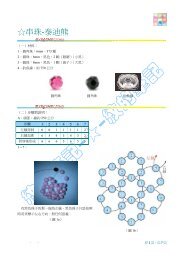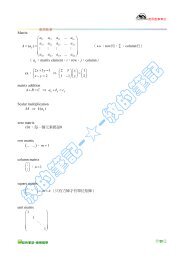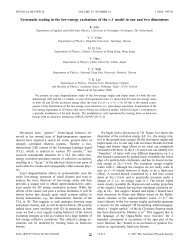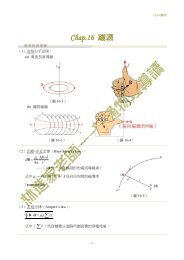Introduction to Nanotechnology
Introduction to Nanotechnology
Introduction to Nanotechnology
You also want an ePaper? Increase the reach of your titles
YUMPU automatically turns print PDFs into web optimized ePapers that Google loves.
CONTENT<br />
• What is <strong>Nanotechnology</strong>?<br />
– Definition and current status of nanotechnology<br />
• Why needs <strong>Nanotechnology</strong>?<br />
– Implications of shrinking device size and fundamental limits<br />
<strong>to</strong> conventional devices<br />
– Technological advancement in fabrication and<br />
characterization<br />
• Misconceptions and Big Promises of <strong>Nanotechnology</strong>!<br />
• Reality and Potential Applications of <strong>Nanotechnology</strong><br />
• Characterization and Fabrication Methods - A primer<br />
• Impact of nanotechnology on economy, society, and<br />
lifestyle<br />
2
What is nanotechnology?<br />
• Definition based on size: Nanoscience and<br />
nanotechnology deal with fabrication and<br />
characterization of structures having<br />
dimensions in the 1-100 nm range.<br />
• Definition based on effects: Nanoscience and<br />
nanotechnology deal with fabrication and<br />
characterization of structures dominated by<br />
quantum effects, size effects, etc. with new or<br />
enhanced properties introduced due <strong>to</strong> nanosize.<br />
• When did it all start? – 1959 Richard Feynman’s<br />
talk “There is plenty of room at the bot<strong>to</strong>m”.<br />
3
What is nanotechnology?<br />
The size of 1nm<br />
=<br />
1mm<br />
1000000<br />
~ 1/10,000 th of a human hair<br />
~ the dimension of 3 gold a<strong>to</strong>ms<br />
4
What is nanotechnology?<br />
More than meets the eyes in the nano world!<br />
5
<strong>Nanotechnology</strong> - definition<br />
• <strong>Nanotechnology</strong> deals with materials and<br />
systems (processing, characterization, testing,<br />
etc.) having following properties:<br />
– Have at least one dimension 1-100 nm.<br />
– Are designed through processes that exhibit<br />
fundamental control over the physical and<br />
chemical attributes of a<strong>to</strong>mic-, molecular-, and<br />
nanometer-scale structures<br />
– Can be combined <strong>to</strong> form larger structures.<br />
– Exhibit unique, new, novel, enhanced or special<br />
properties due the nanometer size.<br />
– All experimental techniques that are needed <strong>to</strong><br />
achieve the above scenarios.<br />
6
Why nanotechnology?<br />
• According <strong>to</strong> Moore’s law, the number of<br />
components per chip is expected <strong>to</strong> double<br />
every 18 months.<br />
• According <strong>to</strong> the International Technology<br />
Roadmap for Semiconduc<strong>to</strong>rs 2001, by the year<br />
2005 dynamic random access memory (DRAM)<br />
½ pitch and microprocessor unit (MPU) ½<br />
pitch are expected <strong>to</strong> decrease <strong>to</strong> 80 nm, while<br />
MPU printed gate length is expected <strong>to</strong><br />
decrease <strong>to</strong> 45 nm.<br />
8
Semiconduc<strong>to</strong>r technology – implications of the<br />
shrinking device size<br />
• Fundamental limits of the optical lithography will soon<br />
be reached. New lithographic technologies need <strong>to</strong> be<br />
developed and implemented. Under development are<br />
extreme UV and X-ray pho<strong>to</strong>lithography.<br />
• With downscaling the size of the conventional devices,<br />
quantum effects, such as carrier tunneling resulting in<br />
increased leakage currents, are undesirable but cannot<br />
be avoided with shrinking size.<br />
• MOS scaling – 0.7x feature size reduction per<br />
generation, ~0.44x switching energy reduction<br />
• Gate oxide scaling – current 0.13µm technologies use<br />
1.5 nm SiO 2 (< 7 a<strong>to</strong>mic layers)<br />
• Gate oxide leakage increasing exponentially with size<br />
reduction.<br />
9
Quantum effects<br />
10
Semiconduc<strong>to</strong>r technology – implications<br />
of the shrinking device size<br />
• Alternatives – different dielectrics, 3-dimensional<br />
double gate transis<strong>to</strong>r structures, etc.<br />
• Nevertheless, fundamental limits of MOS devices<br />
will soon be reached.<br />
• Alternatives – carbon nanotube FETs, Si, GaN<br />
etc. nanowire FETs, single electron transis<strong>to</strong>rs<br />
(main problem – very small size < 5 nm for room<br />
temperature operation), single molecular<br />
switches, quantum dot cellular au<strong>to</strong>mata etc.<br />
11
How small can things get?<br />
• Electron microscope<br />
image of world’s<br />
smallest guitar, made by<br />
researchers from Cornell<br />
University.<br />
• The strings are about<br />
100 a<strong>to</strong>m wide, and<br />
would produce high<br />
pitched sound at<br />
inaudible frequency of<br />
about 10MHz.<br />
12
Why nanotechnology?<br />
• Advantages of small size – some examples<br />
– Novel devices whose operating principle is based on quantum<br />
size effects, so that small physical size would be necessary<br />
instead of detrimental <strong>to</strong> device functioning.<br />
– In electronics, single electron transport devices, such as single<br />
electron transis<strong>to</strong>rs, turnstiles, and pumps, offer the advantages<br />
of good scalability and operation with only several instead of<br />
10000-100000 electrons resulting in very low power<br />
consumption, significant decrease in power dissipation, and<br />
faster switching.<br />
– In tribological coatings, nano-mechanics do not involve<br />
dislocation movement, grain boundary rotation and sliding are<br />
the main deformation mechanisms.<br />
– In polymer-clay nanocomposites, they are light weight<br />
materials that rival metals in stiffness and strength while<br />
providing enhanced gas-barrier characteristics, superior<br />
dimensional stability and high heat-dis<strong>to</strong>rtion temperatures.<br />
13
Why nanotechnology?<br />
– In op<strong>to</strong>electronics, quantum dot lasers offer the advantages of<br />
low threshold current density, suppressed temperature<br />
dependence of the threshold current, and large differential<br />
gain (which enables large modulation bandwidth).<br />
– In sensing applications, nanosensors and nanoprobes are<br />
enabling detection of extremely low concentrations of<br />
molecules in chemical and biological applications and<br />
opening the possibility of intracellular measurements for<br />
biomedical applications which can lead <strong>to</strong> minimally invasive<br />
diagnostic techniques.<br />
– Other applications of nanosize (quantum) dots, such as<br />
ferromagnetic dots for magnetic memories, quantum dots as<br />
spin filter and spin memory, or quantum dot cellular<br />
au<strong>to</strong>mata for quantum computing, have also been proposed.<br />
– In biotechnology, new drug delivery systems and devices can<br />
be made <strong>to</strong> improve efficiency and functionality<br />
14
Misconceptions about nanotechnology<br />
• With nanotechnology everything is possible.<br />
FALSE<br />
• With nanotechnology, we will be able <strong>to</strong><br />
eliminate cancer and diseases and live forever.<br />
FALSE<br />
• With nanotechnology, we can easily clean up<br />
the pollution and colonize space. FALSE<br />
• <strong>Nanotechnology</strong> is dangerous. A mistake with<br />
nanomachines can destroy the entire planet<br />
and just leave grey goo behind. FALSE<br />
15
Big promises<br />
• Nano-machines which can build anything you<br />
want starting from a<strong>to</strong>ms.<br />
• Nano-machines which can swim in your<br />
bloodstream and kill viruses and cancer cells.<br />
• Prosperity, pollution-free industry, almost eternal<br />
life, cure for all diseases, cryonics….<br />
• Smart paints for military applications which can<br />
change camouflage on command and even become<br />
invisible.<br />
• Smart walls in which windows and doors can be<br />
moved on command.<br />
• Growing buildings from “seeds”.<br />
16
Illustration of “nano-machines”<br />
pump<br />
17
Candidate for “nano-mo<strong>to</strong>r”<br />
From Nanozine:<br />
“Researchers Don Noid, Robert<br />
Tuzund and Bobby Sumpter of Oak<br />
Ridge National Labora<strong>to</strong>ry show<br />
nanotubes can become<br />
extraordinarily simple mo<strong>to</strong>rs, when<br />
exposed <strong>to</strong> a oscillating polarized light<br />
source. “<br />
18
Reality<br />
• <strong>Nanotechnology</strong> is rapidly developing field, and its<br />
future is hard <strong>to</strong> predict.<br />
• We are already benefiting from products based on<br />
nanotechnology:<br />
– Tennis balls with 1nm sheets of clay<br />
– Sunscreen with ZnO particles<br />
– Quantum dots for immunoassays<br />
– Carbon nanotube tips for surface probe microscopy<br />
– Textile products (wrinkle resistant, odor dissipating<br />
etc.)<br />
19
Some examples of products already on the market<br />
Application: Catalysts<br />
Company: Exxonmobil<br />
Description: Zeolites, minerals with pore sizes of less than one nanometer,<br />
serve as more efficient catalysts <strong>to</strong> break down, or crack, large hydrocarbon<br />
molecules <strong>to</strong> form gasoline.<br />
Application: Data s<strong>to</strong>rage<br />
Company: IBM<br />
Description: In the past few years, disk drives have added nanoscale layeringwhich<br />
exploits the giant magne<strong>to</strong>resistive effect <strong>to</strong> attain highly dense data<br />
s<strong>to</strong>rage.<br />
Application: Drug delivery<br />
Company: Gilead Sciences<br />
Description: Lipid spheres, called liposomes, which measure about 100<br />
nanometers in diameter, encase an anticancer drug <strong>to</strong> treat the AIDS-related<br />
Kaposi's sarcoma.<br />
Application: Manufacture of raw materials<br />
Company: Carbon Nanotechnologies<br />
Description: Co-founded by buckyball discoverer Richard E. Smalley, the<br />
company has made carbon nanotubes more affordable by exploiting a new<br />
manufacturing process.<br />
Company: Carbolex Inc.<br />
Description: single wall carbon nanotubes<br />
20
Some examples of products already on the market<br />
Application: Materials enhancement<br />
Company: Nanophase Technologies<br />
Description: Nanocrystalline particles are incorporated in<strong>to</strong> other materials <strong>to</strong><br />
produce <strong>to</strong>ugher ceramics, transparent sunblocks <strong>to</strong> block infrared and<br />
ultraviolet radiation, and catalysts for environmental uses, among other<br />
applications.<br />
Application: Immunoassays<br />
Company: Quantum Dot Corporation<br />
Description: Qdot nanocrystals can be used instead of fluorescent-tagged<br />
molecules, colorimetric enzymes, or colloidal gold. Nanocrystals can be<br />
covalently linked using standard conjugation chemistry <strong>to</strong> biomolecules, and<br />
thus used <strong>to</strong> detect binding partners of these molecules in a wide range of<br />
assays. Quantum dots can also be attached <strong>to</strong> antibodies and oligonucleotides.<br />
Application: Surface Probe Microscopy<br />
Company: Piezomax technologies<br />
Description: carbon nanotube SPM tips<br />
Application: Nanocomposite Superhard Coating<br />
Company: Teers<br />
Description: Superhard coatings of Ti-Si-N nanocomposites<br />
21
<strong>Nanotechnology</strong> in textiles<br />
www.nano-tex.com<br />
• Nano-Tex is an advanced materials company which uses molecular<br />
engineering <strong>to</strong> improve textiles.<br />
• By manipulating the architecture and chemistry of structures of<br />
nano-meter <strong>to</strong> sub-micron dimensions, novel and unique<br />
properties of fabrics can be achieved.<br />
• NANO-PEL, NANO-CARE TM fabric technology – wrinkle<br />
resistant and liquid repellent fabrics.<br />
• NANO-TOUCH fabric technology, cot<strong>to</strong>n-like sheath wrapped<br />
around a durable synthetic core <strong>to</strong> combine durability of<br />
synthetics with softness of cot<strong>to</strong>n.<br />
• NANO-DRY enhanced fabrics absorb perspiration in<strong>to</strong> the<br />
fabric and pull it away from the skin. Nano-net absorbent<br />
structure around fibers provides moisture management.<br />
22
Bio-nano-technology<br />
• AFM for biological sample testing – strands<br />
of DNA attached on cantilevers,<br />
complementary sequence binds <strong>to</strong> anchored<br />
strands and bends the cantilever and gets<br />
detected.<br />
• Dendrimers – globular molecules with many<br />
branches. They have voids and can serve as<br />
drug or DNA delivering vehicles.<br />
• Nanoshells – gold coated glass beads. Can be<br />
injected in<strong>to</strong> the body and heated by outside<br />
strong IR source <strong>to</strong> release drugs or kill<br />
cancer cells. – research at Rice University.<br />
• Repair of damaged tissues – building<br />
scaffolding for bone growth etc.<br />
23
Drug delivery<br />
• Targeted drug therapy is of enormous interest<br />
for medicine. This provides opportunity <strong>to</strong><br />
deliver drugs, radioactive particles or <strong>to</strong>xins <strong>to</strong><br />
specifically kill affected cells without damaging<br />
surrounding healthy tissue.<br />
• Implications – significant reduction in side<br />
effects of treatments such as chemotherapy<br />
which also kills healthy cells or s<strong>to</strong>ps cell<br />
growth.<br />
24
Nano-medicine<br />
• Applications in biomedical research, disease<br />
diagnosis and therapy.<br />
• Faster, more sensitive and more flexible<br />
biological tests measuring the presence of<br />
activity of selected substances with<br />
nanostructures as tags, labels or sensors.<br />
• Nanoparticles can be used for drug delivery<br />
just where the drugs are needed. Minimization<br />
of therapy side effects.<br />
• Artificial nanoscale building blocks for tissue<br />
repair and organ regeneration.<br />
25
Quantum dot corporation<br />
26
Nanocrystals for solid state lighting<br />
• Alternative <strong>to</strong> size controlled emission – localized<br />
impurity inside a nanocrystal. [J. Crystal Growth, 214-<br />
215, 926 (2000)].<br />
• Emitted wavelength depends on the localized impurity<br />
a<strong>to</strong>m – less stringent control of size needed. As the size<br />
of nanocrystal decreases, efficiency of light emission<br />
increases.<br />
• Dopants – rare earth a<strong>to</strong>ms, europium for red, terbium<br />
for green and thulium for blue.<br />
• Nanocrystals Technology Inc., organized nanocrystal<br />
Lighting Corporation in April 2002 <strong>to</strong> exploit<br />
nanocrystals for solid state lighting.<br />
27
Carbon nanotube applications<br />
• Applications: SPM tips, field emission displays,<br />
pro<strong>to</strong>type memories and electronic devices<br />
reported.<br />
• Nantero, Woburn, Mass. – non-volatile random<br />
access memory – based on carbon nanotubes.<br />
Pairs of carbon nanotubes s<strong>to</strong>re data by locking<br />
<strong>to</strong>gether when current runs through them.<br />
They remain linked until separated by counter<br />
current, so memory is retained.<br />
28
Carbon nanotubes-displays application<br />
• Field emission display<br />
using carbon nanotubes.<br />
• Choi et al. Appl. Phys.<br />
Lett., 15 Nov., 1999.<br />
• Samsung Advanced<br />
Institute of Technology<br />
29
Piezomax Technologies<br />
30
Piezomax Technologies<br />
31
<strong>Nanotechnology</strong> applications<br />
• Cleaner energy<br />
– Hydrogen fuel cells – energy produced from<br />
hydrogen and oxygen, byproduct – water.<br />
– Needs nanoscale catalyst (platinum) particles.<br />
– Needs hydrogen extraction or s<strong>to</strong>rage. Carbon<br />
nanotubes promising for this application.<br />
• Coatings<br />
– Nanocrystalline or nanocomposite:<br />
• Superhardness (> 40 GPa)<br />
• anti-corrosion,<br />
• wear protective,<br />
• decorative or functional, etc.<br />
32
Polymer-clay nanocomposites<br />
Lightweight materials containing nanocomposites promise <strong>to</strong> rival metals in stiffness and<br />
strength, while providing superior dimensional stability and heat dis<strong>to</strong>rtion properties.<br />
TEM micrographs of<br />
polyethylene/4% verniculite<br />
(a clay) nanocomposite<br />
showing the formation of<br />
exfoliated vermiculite layers<br />
in the composite.<br />
33
Nanobalance<br />
• P. Poncharal et al.,<br />
Science March 5,<br />
1999.<br />
• Principle of<br />
operation – mass<br />
attached at the end<br />
of nanotube shifts its<br />
resonant frequency.<br />
From frequency<br />
shift, mass can be<br />
determined.<br />
34
AFM applications<br />
• Lutwyche et al. Appl. Phys.<br />
Lett. 13 Nov. 2000<br />
• An array of 1024 tips is<br />
scanned over a thin<br />
polymer film used as a<br />
s<strong>to</strong>rage medium.<br />
• Each tip can be addressed<br />
individually by a timemultiplexing<br />
system which<br />
was adapted from DRAM<br />
technology.<br />
35
Drug delivery<br />
• Challenge in drug delivery – crossing the<br />
cellular barrier. Important in the case of<br />
nose, intestine, and the skin. For lung,<br />
main difficulty is in getting the drug <strong>to</strong><br />
the deep lung.<br />
• Microchips containing nanosized drug<br />
reservoirs (image on the left) could<br />
deliver drugs in controlled manner over<br />
prolonged period of time.<br />
Science 293, 58 (2001)<br />
36
DNA self-assembly<br />
• G. C. L. Wong et al. Appl.<br />
Phys. Lett. Oct. 5, 1998.<br />
• J. O. Rädler et al. Science 275,<br />
810 (1997).<br />
• Negatively charged DNA on<br />
positively charged artificial<br />
membranes.<br />
• Uses – delivery vehicles in<br />
gene therapy, templates for<br />
fabrication of inorganic<br />
nanostructures,<br />
electrophoretic media for<br />
sorting molecules.<br />
37
DNA – a semiconduc<strong>to</strong>r<br />
• D. Porath et al. Nature,<br />
10 Feb. 2000.<br />
• DNA – large bandgap<br />
semiconduc<strong>to</strong>r.<br />
• Experiment performed<br />
at DIMES institute, Delft<br />
Institute of Technology.<br />
38
Quantum coral<br />
• Manorahan et al. Nature, Feb.<br />
3, 2000. 36 cobalt a<strong>to</strong>ms in<br />
quantum corral structure on<br />
copper substrate, one cobalt<br />
a<strong>to</strong>m at focus of the ellipse.<br />
Electron waves moving in the<br />
copper substrate interact with<br />
magnetic cobalt a<strong>to</strong>m at one<br />
of the foci. At another focus<br />
there is a “mirage” of another<br />
cobalt a<strong>to</strong>m which isn’t really<br />
there.<br />
• Don Eigler, IBM. STM<br />
picture of quantum corral<br />
made by positioning iron<br />
a<strong>to</strong>ms on a copper surface.<br />
39
Helical nanowires<br />
• Zhang et al., Nanoletters<br />
2, 941 (2002).<br />
• SiC nanowires covered<br />
with silicon oxide sheath.<br />
Diameter of SiC core 10-<br />
40 nm with helical<br />
periodicity 40-80 nm,<br />
covered by 30-60 nm<br />
amorphous SiO 2 .<br />
40
Key issues in nano-manufacturing<br />
• Precursor nanomaterials and nanoparticles<br />
• Fabrication of nanostructures<br />
• Characterization and processing<br />
• Theory, modeling, simulation, and control<br />
• Design and integration of nanodevices and<br />
systems<br />
• Nano-manufacturing education and<br />
dissemination strategies<br />
41
Fabrication of nanostructures<br />
There are two approaches:<br />
• Approach I: Assembly of prefabricated nanocomponents<br />
(clusters, tubes, wires)<br />
1. nanocomponent fabrication,<br />
2. nanocomponent sorting and selection, and<br />
3. nanocomponent assembly in<strong>to</strong> devices.<br />
Can produce large quantities of nanocomponents in<br />
inexpensive manner, steps 2 and 3 are problematic.<br />
• Fabrication of the individual nanocomponents is typically low<br />
cost, high speed process. There are numerous fabrication<br />
methods, such as different methods of gas phase synthesis,<br />
colloidal synthesis etc. Main disadvantages of this process are<br />
poor purity and composition control, and wide size and shape<br />
distribution. In addition, post-synthesis processing of these<br />
nanostructures is very difficult.<br />
42
Fabrication of nanostructures<br />
• Approach II: Direct deposition of nanostructures on<br />
the substrate.<br />
QD lasers based on InGaAs material system have<br />
been demonstrated.<br />
• Advantage: compatible with conventional device<br />
processing technologies. The disadvantages: higher<br />
cost and the need <strong>to</strong> develop novel solutions <strong>to</strong><br />
achieve good size control of the fabricated<br />
nanostructures.<br />
43
Growth of nanostructures<br />
• Early quantum dot (QD) works were based on<br />
etched QDs. The PL efficiency of such QD<br />
devices was low and decreasing with dot size, so<br />
that PL spectra of 60 nm QDs was only about<br />
1% of the PL of the mesa structure.<br />
• Majority of QDs fabricated by self-assembly.<br />
• Free standing nanostructures fabrication – selfassembly<br />
• Various organic nanostructures – self-assembly.<br />
44
Free standing nanostructures<br />
• Free standing<br />
nanostructures (nanowires,<br />
nanoribbons, nanotubes,<br />
nanorings) can be<br />
synthesized in relatively<br />
simple and inexpensive<br />
manner.<br />
SnO 2 nanoribbons<br />
Solid State<br />
Communications 118, 351<br />
(2001).<br />
45
GaN nanorings<br />
Free standing nanostructures<br />
Appl. Phys. A 72, 629 (2001)<br />
GaN 1D nanostructures<br />
Appl. Phys. A 71, 587 (2000).<br />
46
Free standing nanostructures<br />
FESEM - ZnO nanorods<br />
47
Science 297,787 (2002)<br />
Carbon nanotubes<br />
• A,B, C – schematic<br />
representation of single<br />
wall CNTs<br />
• D) TEM of 1.3 nm<br />
SWNT<br />
• E) TEM of multiwall<br />
CNT<br />
• F) TEM image of lateral<br />
packing of 1.4 nm<br />
SWNTs<br />
• G) SEM image of<br />
MWNT array<br />
48
Carbon nanotubes<br />
• Types – single wall and multiwall (several<br />
layers rolled in<strong>to</strong> cylinders. Single wall carbon<br />
nanotubes can be either metals or<br />
semiconduc<strong>to</strong>rs depending on the chirality<br />
(chiral angle between hexagons and tube axis).<br />
• Band gap is inversely proportional <strong>to</strong> the<br />
diameter for same chirality.<br />
• Manufacturing methods: arc discharge, laser<br />
ablation and chemical vapor deposition.<br />
49
Carbon nanotube<br />
• Laser ablation & arc discharge – high quality nanotubes<br />
with low number of defects, but many byproducts.<br />
• CVD – metal catalysts as seeds, hydrocarbon gases as<br />
sources.<br />
• None of the methods produces bulk materials with same<br />
diameters and chirality.<br />
• CVD growth on patterned substrates – ordered arrays of<br />
nanotubes. Electric field can be used <strong>to</strong> control the growth<br />
directions.<br />
• For details on CNTs, see: Science 297,787 (2002), Critical<br />
Reviews in Solid State and Materials Sciences 26(3), 145<br />
(2001), H. Dai, Acc. Chem. Res. 2002.<br />
50
Carbon nanotubes<br />
• Small diameter, single wall CNTs have high<br />
Young’s modulus and high tensile strength –<br />
light, stiff and strong material.<br />
• Impurities – carbon coated metal particles,<br />
amorphous carbon, fullerene. Typically<br />
removed with acid and/or heating, which can<br />
damage tubes and introduce other impurities.<br />
51
Field emission<br />
• Potential applied between nanotube or<br />
nanowire coated surface and anode produces<br />
high local fields as a result of small radius of<br />
nanostructure.<br />
• High local fields cause tunneling of electrons<br />
from nanotube (nanowire) tip in<strong>to</strong> vacuum.<br />
• Electric fields direct electrons <strong>to</strong> anode, where<br />
a phosphor produces light.<br />
52
Carbon nanotubes-display application<br />
Science 297,787 (2002)<br />
• A) Schematic illustration<br />
of a carbon nanotube<br />
display<br />
• B) SEM image of an<br />
electron emitter<br />
• C) 5 inch nanotube field<br />
emission display made<br />
by Samsung.<br />
53
Science 297,787 (2002)<br />
Nanoelectronic devices<br />
A) schematic diagram of carbon<br />
nanotube FET<br />
B) STM image of SWNT FET<br />
C) Image and schematic<br />
representation of electrical<br />
pulses removing layers of<br />
MWNT <strong>to</strong> reveal layers with<br />
desired transport properties.<br />
D) STM image of a nanotube<br />
having different helicity on<br />
opposite sides of a kink – one<br />
side is metallic, the other is<br />
semiconducting.<br />
54
Hurdles <strong>to</strong> overcome:<br />
Lack of size uniformity and order<br />
Control of shape of nano-objects<br />
Substance purity<br />
Control of crystal structure<br />
55
<strong>Nanotechnology</strong>- present and future<br />
• Efforts of past 10 years have identified<br />
important consequences and applications of<br />
nano science and technology<br />
• To reap these benefits, R&D in the future<br />
need <strong>to</strong> master ways <strong>to</strong> control the shape,<br />
size and placement of nano objects<br />
• In order <strong>to</strong> accomplish this aim, joint efforts<br />
and fabrication ideas from fields of physics,<br />
engineering, chemistry and biology are<br />
needed.<br />
56
Impact of nanotechnology<br />
• If self-replicating universal assemblers and medical nanobots could be<br />
achieved, impact would be enormous.<br />
• Economic implications – no limits <strong>to</strong> growth, does not conform <strong>to</strong><br />
conventional supply and demand. Obsolescence, substitution and<br />
aftermarket driving the demand.<br />
• Societal implications – no value of labour in basic industries. Increased<br />
leisure will not necessarily result in pursuit of knowledge.<br />
• Geopolitical implications – use of nanomachines as weapons, in wars and by<br />
terrorists and “rogue leaders” (Iraq etc.).<br />
• Longevity implications – limiting population growth and limiting evolution<br />
potential, socio-legal problems (crime and punishment, suicide), eugenics,<br />
and superhumanism.<br />
• Fortunately – realizations of self-replicating universal assemblers and<br />
universal repair medical nanobots are not likely.<br />
• For detailed discussion on “nanotechnology what ifs”, see: NanoTechnology Magazine, 3:5, June-July,<br />
1997, 1-6, NanoTechnology Magazine, 2:4, April, 1996, pp. 2-3; NanoTechnology Magazine , 2:5, May,<br />
1996, pp. 4-6; NanoTechnology Magazine, 2:6, June, 1996, pp. 7-10; NanoTechnology Magazine, 2:7,<br />
July, 1996, pp. 6-9; and NanoTechnology Magazine, 2:8, August, 1996, pp. 3-5.<br />
57
Economic growth<br />
Impact of nanotechnology<br />
Better, cheaper products<br />
Advances in diagnostic<br />
techniques<br />
Improved disease and cancer<br />
treatment<br />
+<br />
Benefits <strong>to</strong><br />
individuals<br />
Benefits <strong>to</strong><br />
society<br />
58

















